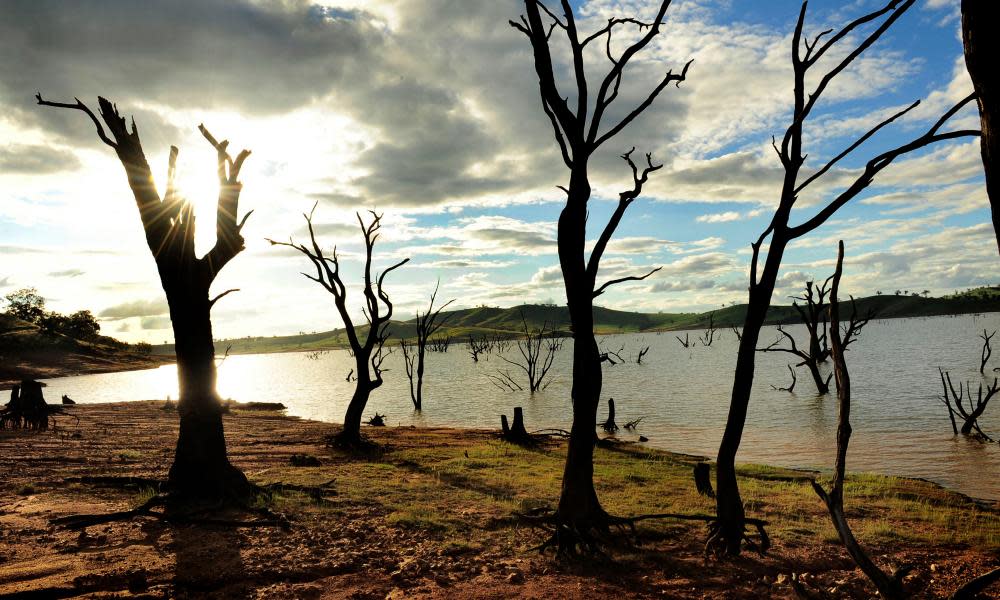Murray-Darling water plan will fail without urgent action, report warns

The Murray-Darling basin plan will fail unless the federal government recommences water buybacks, invests in regional development projects to support struggling communities and cracks down on state governments undermining the effectiveness of environmental flows, a new report has said.
The report by the Wentworth Group of Concerned Scientists, released on Monday, warned that the $7.1bn spent since 2007 on implementing the plan would be wasted unless minimum environmental flow levels were met to provide long-term protection of vulnerable ecosystems.
Five years after the Murray-Darling Basin Authority set a target of recovering 3,200 gigalitres of water a year through buying back water licences and improving irrigation efficiency, just two-thirds of it has been met.
Water flows are sufficient to flush 1m tonnes of salt from the system each year, half the basin plan target of 2m tonnes, and while there have been localised environmental improvements, there was no evidence to demonstrate improvement across the basin as a whole, the report said.
The basin plan has a formal water recovery target of 2,750GL but includes a mechanism to increase that to 3,200 GL. Even if the full target were reached – which is contingent on states and territories agreeing that the final 450GL can be recovered without a negative socioeconomic impact – it would not be enough to ensure the Murray mouth flowed without being dredged in non-flood years.
“[The target] has a very high risk of failure for achieving the environmental benefits that the plan was supposed to provide,” the lead author of the report, Australian National University associate professor Jamie Pittock, told Guardian Australia. “Less than 3,200GL is asking to repeat this whole exercise in five or 10 years when the next big drought hits.”
Pittock said the economic impact of the plan was unclear because reporting around its environmental and socioeconomic impacts had not been transparent. Some towns, such as Moree and Collarenebri in western New South Wales, and Deniliquin in Victoria, have reported economic hardship. Others, such as Shepparton on Victoria’s Goulburn river, and Griffith, on the Murrumbidgee in the NSW Riverina, where frustrated farmers burned the Murray-Darling basin plan in protest when it was released in 2010, have experienced a period of economic growth.
The Wentworth Group is calling for at least 10% of the $5.9bn remaining of the original $13bn investment pledged by the Howard government to go towards regional development projects to help struggling communities reduce their reliance on irrigation water.
So far, Pittock said, the bulk of the money had been spent on “pouring concrete for irrigators”, which has not helped struggling small businesses in irrigation towns. Less than 1% had been spent on the broader community, he said.
The Wentworth Group also wants water to be made a permanent item on the agenda of Council of Australian Governments meetings and for the federal government to require stricter compliance from NSW and Victoria, which are both limiting environmental releases in key river systems.
NSW has limited the maximum permitted water release through the Murrumbidgee at Gundagai from 50ML per day to 30ML a day, and Victoria has limited releases in the Goulburn river below Shepparton from 40ML a day to 25ML a day. The effect of both caps is that water remains in the river banks rather than spreading on to floodplains, which prevents the system from flushing further downstream.
“By chopping off environmental river flows, the states are effectively condemning huge tracts of South Australia to be salinated wastelands,” Pittock said.
The agriculture minister, Barnaby Joyce, said the economic woes of smaller towns in the upper basin were due to an over-purchase of irrigation licences by the Rudd and Gillard governments.
The plan was developed by the then water minister, Malcolm Turnbull, but about 80% of the buybacks occurred between 2009 and 2012, when Labor was in power.
“They swept into Collarenebri and bought all the water,” Joyce told AM on Monday. “It’s like going to Sydney and closing all the roads. You’ve got no economy after that. It’s bizarre but they did it, and now I’ve got to try and make sure that we don’t duplicate that.”
Joyce said the recovery of the final 450GL of water, which makes up the target of 3,200GL and which scientists say is critical if the plan is to have any hope of working, was currently the subject of a socioeconomic assessment.
If recovering that water was deemed to hurt farming communities then under the Water Act it would not be recovered, Joyce said.
“I’ll comply with the legislation,” he said. “Each state is going to come to you and quote their views on it, it’s a very contentions issue, but I’m resolved to see it through that process. There’s an independent review happening right now.”

 Yahoo News
Yahoo News 
